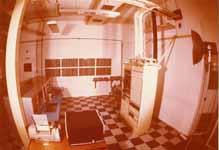Example 1 - flags and bit insert/delete
Analyzing directly from the bits on the line is not
something you will need to do in practice because all protocol testers
do this automatically.
However try this example to get an insight into how
the datastream is divided into frames.
Here is another example worked through
______________________________________
0100110111111011000000111110100110110100011011101111110110
----><------> ^ <------><---
end of this a zero flag start
last pattern following of next
frame must be five ones frame
a flag must have
wherever n inserted
it occurs for transparency
so remove it
this leaves the following,
1100000011111 1001101101000110111
divide up into bytes,
11000000 11111100 11011010 00110111
<---------------->
the sixteen bits
before the flag is
always the frame
check sequence
<------>
this is the
control byte
the LSB is
transmitted
first so it
is 3F in hex
which identifies
this as a SABM
frame.
<------>
this is
03 in hex
which is
address A
Now try the example yourself - don't worry about what type of frame it is - just decode it to HEX
Hexadecimal 0= 0000
1= 0001
2= 0010
3= 0011
4= 0100
5= 0101
6= 0110
7= 0111
8= 1000
9= 1001
A= 1010
B= 1011
C= 1100
D= 1101
E= 1110
F= 1111
Example 1 - answer
__________________
1100111111000000011111011110011111100111
<------> ^ <------>
flag bit flag
inserted
flags and
'bit stuffing' 0000001111111110
removed
value in hex C0 7F
(low order bit of
each byte
transmitted first)
all frames must have at least 4 bytes so this is
not a valid frame
______________
| slide EX 2 |
______________
* This slide was made up from a printout from a halcyon
(the halcyon screen is the same except it does not have
the line with all thNNNNN's)
* each byte is represented by two hex digits above
& below each other e.g.,
4
C = 01001100
(see Hexadecimal for coding)
* the display is read left to right / top to bottom
* both directions of transmission are displayed
top is from host to network
bottom is from network to host
the trace then continues in pairs like this down
the screen
* the flags (7E) are suppressed
apart from the last flag in each frame
* the 16 byte FCS at the end of each frame is suppressed
* - when the draughsman drew out this slide he squashed up some of
the rows so that they do not line up (all frames end with 7E).
Example 2 - Answer
__________________
First frame - 03 EA 14 00 02 48 45 4C 4C 4F
- address = 03 = A - network to host so this is a
command
- control = EA = 11101010
<->^<->^
| | | +-- this is an I frame
| | +---- N(S)=5
| +------ P=0
+-------- N(R)=7
- packet level is 14 00 02 48 45 4C 4C 4F
- FCS not displayed
Second frame - 01 CE 14 00 41
Address = 01 = B - host to network so this is a command
Control = CE = 11001110
<->^<->^
| | | +-- 0 so this is information frame
| | +---- N(S) = 7
| +------ P=0
+-------- N(R) = 6
Data = 14 00 41
FCS not displayed
Third frame - 01 01
- address = 01 = B - network to host so this is a
response
- control = 01 = 00000001
<->^<-->
| | +--- this is an RR frame
| +------ P=0
+-------- N(R)=0
- RR frames do not have an I field
- FCS not displayed

